Are you ready to learn the basics of wine tasting? Whether you’re an experienced sommelier, just enjoy a glass of wine once in a while or in a blind tasting, learning a few simple steps can help you appreciate the finer points of this noble beverage. In this article, we will provide an overview of the five S’s of tasting: See, Swirl, Smell, Sip and Savor.
How to Taste Wine for Beginners – The 5 S’s and Systematic Tasting
Wine tasting can be an intimidating experience, especially if you’re new to it. However, with the right approach and knowledge of the basics, you can discover a whole new world of flavors and aromas in your glass when you taste wine.
One popular method for wine tasting is called Systematic Tasting, which involves following five steps known as the 5 S’s:
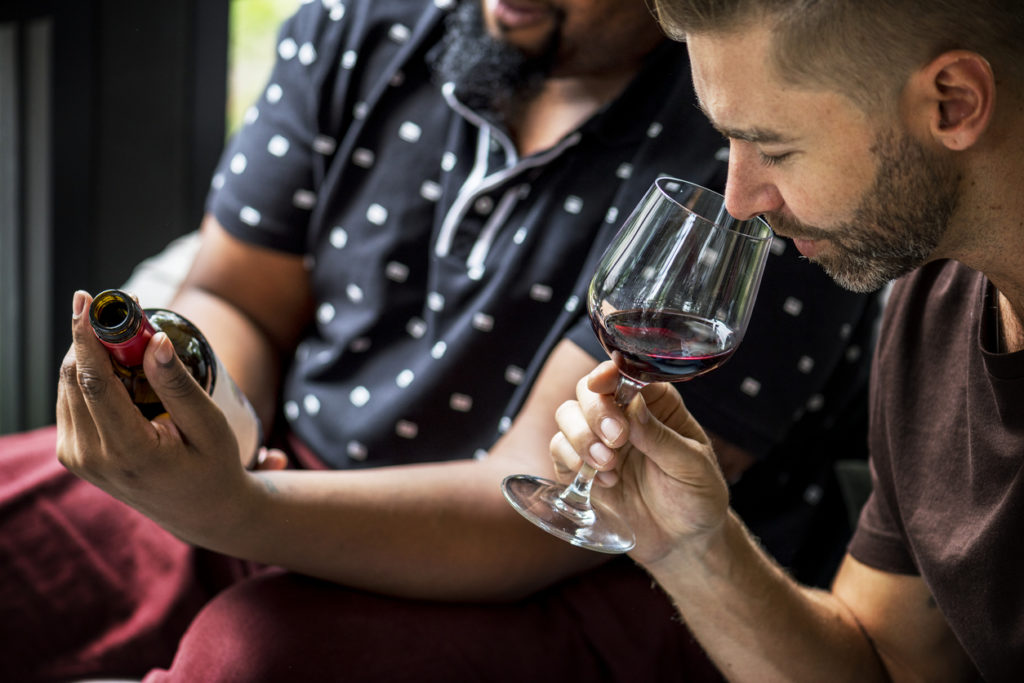
See:
Inspect the wine under neutral lighting against a white background if possible before you taste wine
Swirl:
Swirl the wine in the glass to help develop the aroma. Observe the wine legs!
Smell:
Identify the aroma of the wine by breathing through your nose
Sip:
Taste the fine to identify the aromas and acidity
Savor:
Put together the different impressions you`ve gained in the first 4 steps to conclude your verdict on the wine! Make tasting notes.
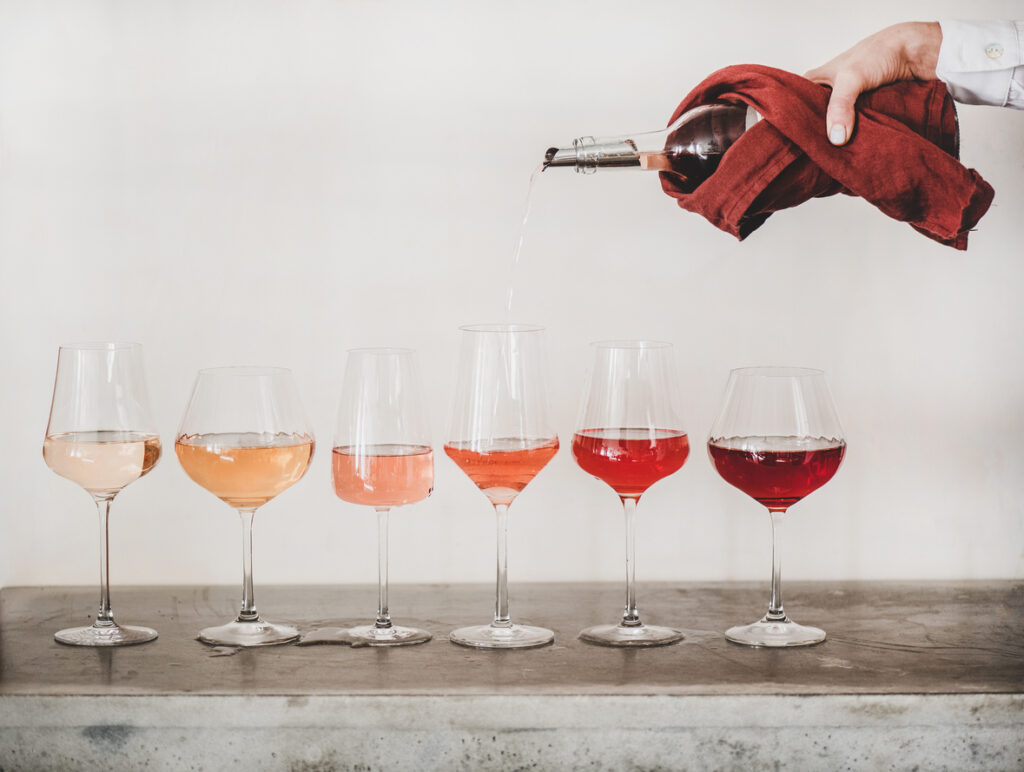
Evaluating by Sight – Step 1
One of the first things you should know about connoisseur wine tasting or a blind tasting is how to analyze its appearance. The color, opacity, and wine legs are all critical factors that can help you determine the quality and flavor of a particular vintage.
The color of wine can vary significantly depending on the grape variety and age. For example, reds typically range from light ruby to deep garnet hues. White wines can vary from pale yellow to golden colors. To assess the color properly, hold your glass up against a white background or in natural light, then tilt it slightly and observe the hue.
Another key factor in a wine tasting experiment is to evaluate the wine`s appearance and opacity. The more opaque a wine is, the denser it will be on the palate. Opacity also affects how well-aged a wine appears since older wines tend to have less vibrant colors than younger ones.
This first step can be done quickly nevertheless it`s important!
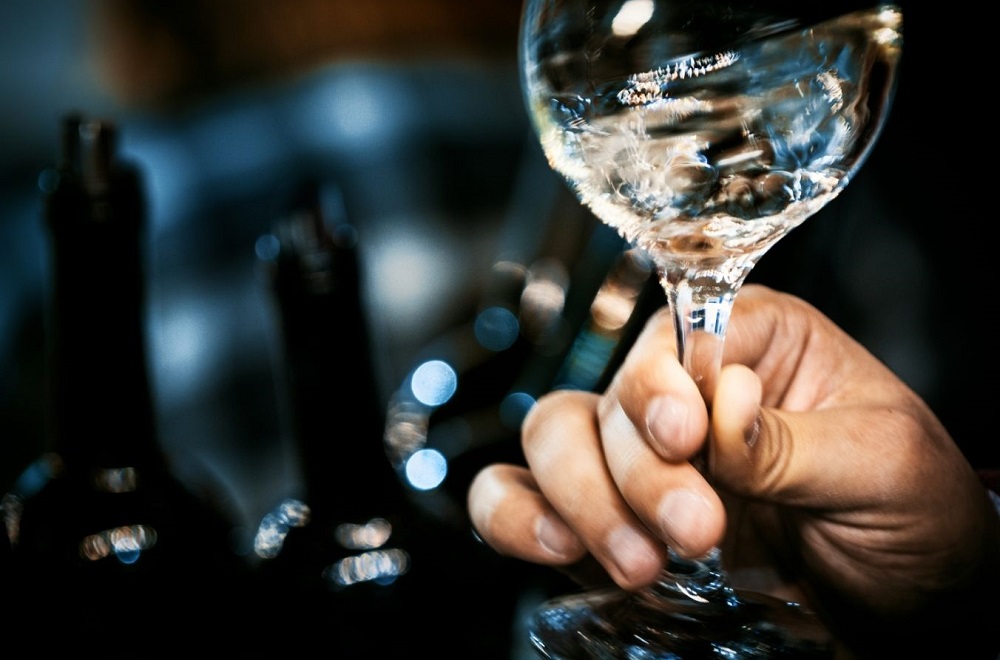
Step 2 – Swirl
Swirling the wine in your glass will help you notice how thick it appears or if it leaves ‘wine legs’ on the sides of your glass. Wine legs are streaks or tears that form on a glass after swirling indicating alcohol content and sugar levels, which can give you an insight into what to expect from your drink’s taste profile.
Malbec will have a magenta to pink rim
Pinot Noir often has a dark red to ruby colour. Cooler climates emphasize this effect
Grenache or Nebbiolo based wines often are translucent at their rim with ranging from orange to garnet.

Step 3 – Sniff
If you’re a wine enthusiast, then you know that the aroma of wine is just as important as its taste. In fact, our sense of smell can detect over 1 trillion different scents, and wine has around 200 different compounds that contribute to its aroma. So how do you properly smell wine and identify its primary, secondary, and tertiary aromas?
Primary Aroma
Firstly, give your glass a swirl to release the aroma. This will also increase the surface area of the wine in contact with air and help it breathe. Next, place your nose into the glass and take a deep sniff to pick up on primary aromas such as fruit and floral notes. Primay aroma are derived from the grape varietals which are used for the wine.
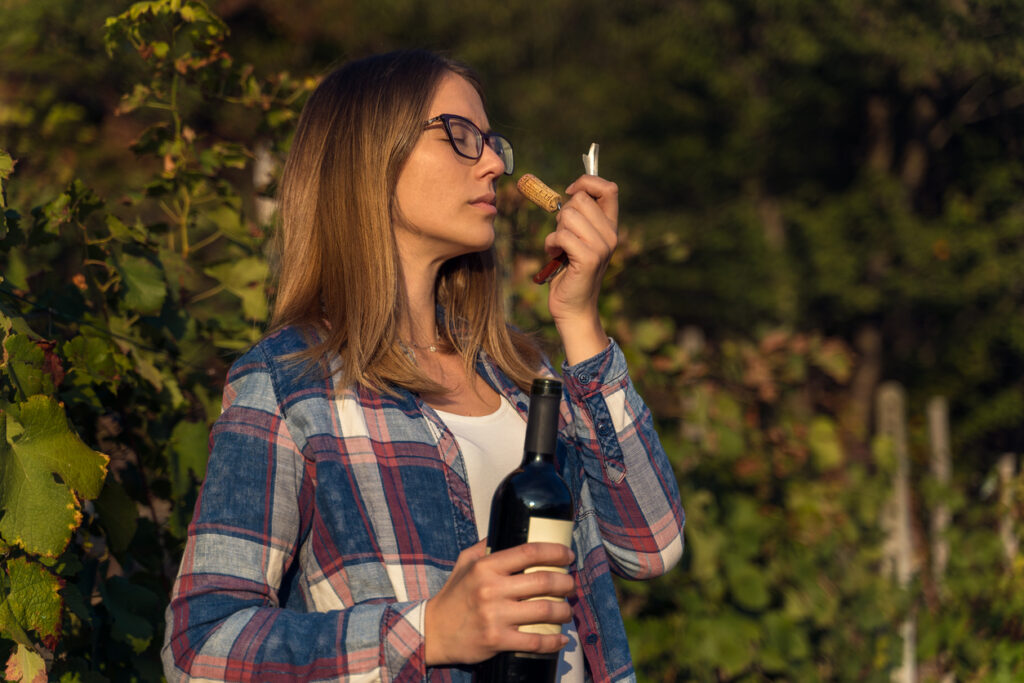
Secondary Aroma
They will emerge after swirling the wine for a few seconds. Secondary aroma can be described as more complex scents like spices or herbs, nuts or stale beer. Secondary aroma are the product of the yeast which is used for the fermentation of the grape juice.
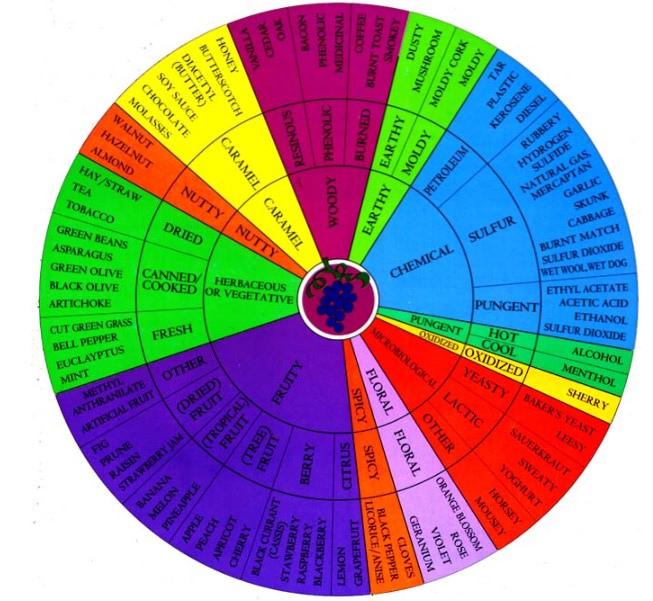
An important process to influence the aroma of wine is malolactic fermentation. Here a tart acidic white wine can be turned into a smooth, buttery round wine. Depending on the wine region this is often done with Chardonnay wines.
Tertiary Aroma
Finally, let’s talk about tertiary aromas which develop over time through oak aging or bottle aging. These include vanilla which comes from oak ageing, baking spices, coconut, cedar or old tobacco and roasting notes.
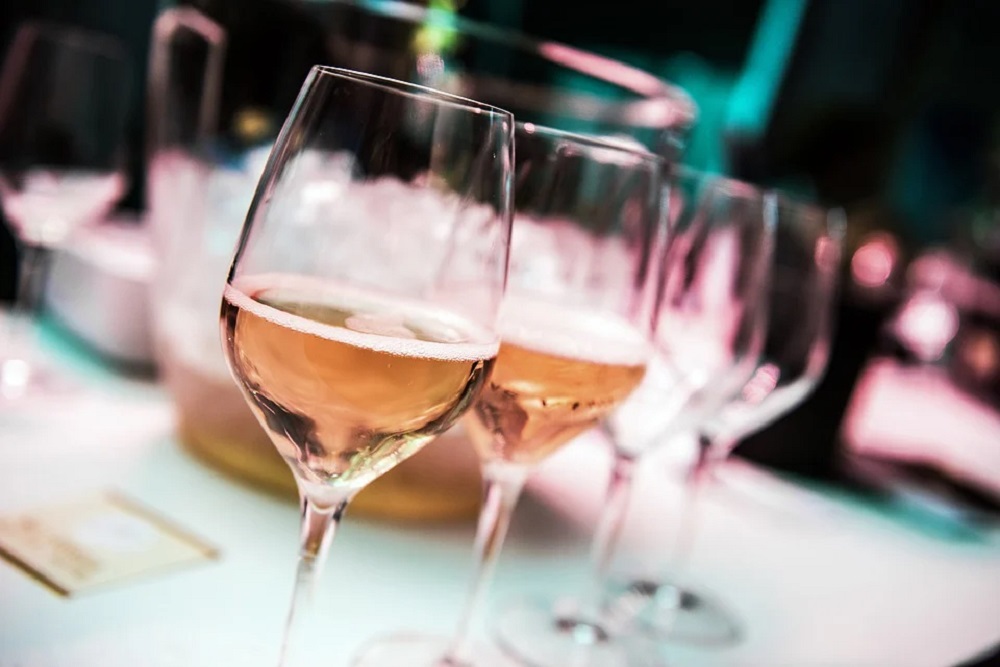
Step 4 – Sip the wine
Sipping wine is an art form that requires patience, practice, and a keen sense of taste. The primary goal of sipping wine is to experience the nuanced flavors and aroma that each varietal has to offer. To begin, always start with a clean palate by avoiding strongly flavored foods or drinks for at least an hour prior to tasting.
When you are ready to sip your wine, take a small amount into your mouth and hold it there for a few seconds before swallowing. This allows your taste buds to fully perceive the flavors in the wine. As you swallow, pay attention to the primary aroma or “nose” of the wine – this refers to the initial scent you pick up from it.
In this step sweet wines which are used as dessert wines can be easily identified.
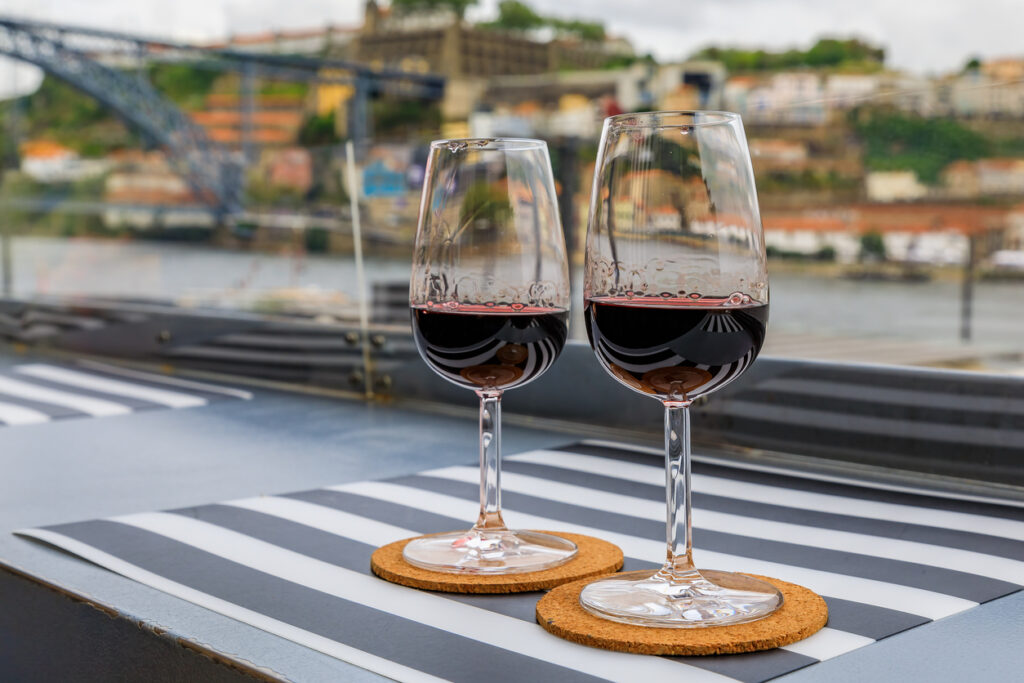
After swallowing, continue paying attention as secondary and tertiary aromas emerge – these are scents that develop once the wine has been exposed to oxygen in your mouth.
Depending on the intensity of the secondary and tertiary aromas you will be able to identify them while swirling the wine glass and sniffing the wine.
Step 5 – Savor the wine
Combine the impressions you`ve made in the first 4 steps. This is the most important step in a wine tasting. You can make tasting notes to compare your impressions. What colour did the wine have when swirling it in the wine glass? Were there any unique characteristics? Was it a cheap table wine or an expensive wine?
Sweetness of wine
Wine is one of the most popular beverages in the world, and its taste is a crucial factor that determines how much people enjoy it. One key determinant of wine’s taste is residual sugar content. Residual sugar refers to the amount of natural grape sugars left over after fermentation. This sugar can significantly affect a wine’s sweetness level, which in turn influences its overall taste.
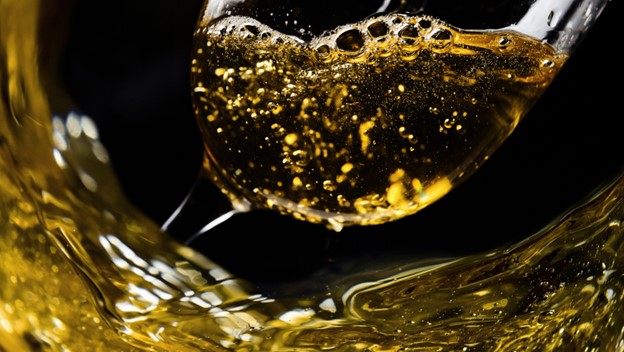
The influence of sweetness on wine taste can be seen across all types of wines, from red to white to sparkling varieties. Wines with higher levels of residual sugar tend to have a sweeter flavor profile and are often perceived as fruitier or more floral than drier wines. Conversely, wines with lower levels of residual sugar generally have a dryer and more acidic taste.
In addition to affecting the overall taste profile, sweetness also plays an essential role in balancing out other flavors within a given wine.
Acidity of wine
The acidity of wine is one of the most important factors that contribute to its overall taste. A higher level of acidity can create a zesty, refreshing flavor while a lower level can result in a flat or dull taste. The influence of acidity on the taste of wine is particularly notable in white wines such as Pinot Grigio.

Pinot Grigio is known for its crisp, bright flavor and refreshing finish. This is largely due to the high levels of acidity found in this varietal. The tartness creates a lively sensation on the palate that enhances other flavors present in the wine, such as citrus or green apple notes.
However, it’s important to note that there is a balance between acidity and other elements such as sweetness and tannins when it comes to creating an enjoyable tasting experience.
Bitterness or Tannins
Wine is a complex beverage with many factors contributing to its taste. One of the most significant components that affect wine flavor is tannin. Tannins are natural compounds found in grape skins, seeds, and stems or added through oak barrels during aging. These compounds are responsible for mouthfeel and bitterness in wine.
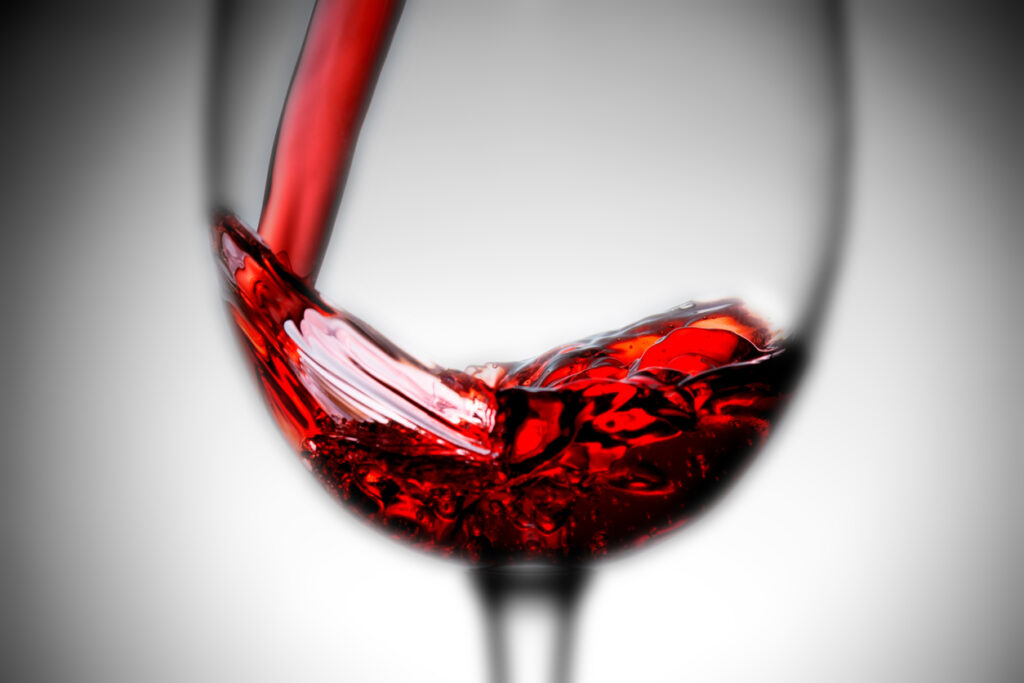
Grape tannins come from the skin of grapes, where they help protect the fruit from pests and damage. The level of grape tannins varies depending on the type of grape and where it was grown. Red wines generally have more tannin than white wines because the juice is fermented with the skins intact, while white wines undergo a pressing process that removes them.
Oak tannins add another layer to wine taste by providing flavors like vanilla, spice, and toastiness. These compounds come from oak barrels used during aging and can significantly impact a wine’s profile.
Influence of tannins
Tannins play an essential role in determining the texture and structure of red wines. When tannins are present in high concentrations, they can make a wine taste harsh or overly bitter. On the other hand, when tannin levels are too low, reds can appear thin and lack body.
Grape varietals with a high tannin content are cabernet sauvignon, mourvedre, carignan, nebbiolo and sangiovese. Lower tannin containig red grape varietals are pinot noir, gamay and merlot.
Mash fermentation is a crucial process in wine making, especially for red wines. During the maceration process, tannins are extracted from the grape skins and seeds, which significantly impact the final taste of the wine.
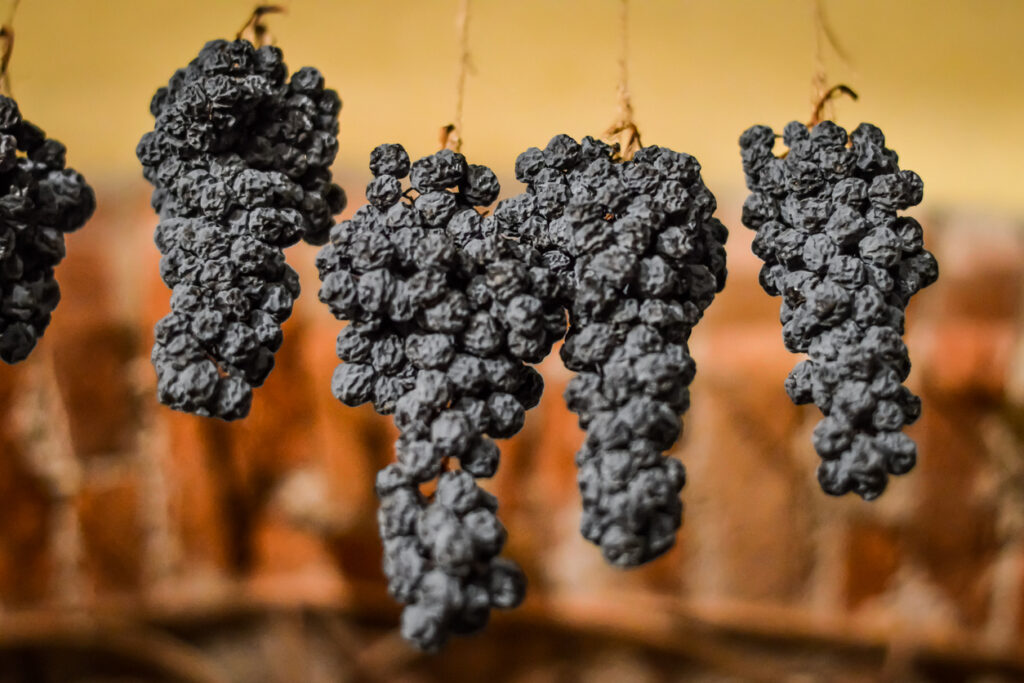
Tannins are natural compounds found in grape skins, stems and seeds that give red wines their characteristic bitterness and astringency. They`re also formed during the storage of red wine in large oak vats by the oxidative addition of phenols to form polyphenols (tannins).
The tannin content of wine also influences the temperature at which the wine can be consumed. The higher the tannin content the warmer the wine can be when consumed.
Alcohol
Alcohol content plays a significant role in the taste of wine. It affects both the aroma and flavor profile of the wine, making it a crucial element in determining the quality of a vintage. The amount of alcohol present can have an impact on how the wine tastes and feels in your mouth, and its influence can be felt throughout every stage of production.

One way that alcohol affects wine is through its ability to extract more flavor compounds from grape skins during fermentation. This process helps to intensify the overall aromas and flavors found within each bottle. However, too much alcohol can overpower these flavors, leading to an unbalanced taste sensation that leaves you with an unpleasant aftertaste.
Another way that alcohol influences wine is through its effects on body and texture.
Body of Wine
When it comes to wine tasting, one of the most commonly used terms is “body”. Body refers to the weight and viscosity of wine in your mouth. It can also be described as the texture or feel of the wine. Generally speaking, wines with more body will have a thicker, heavier texture while lighter-bodied wines will be less dense.
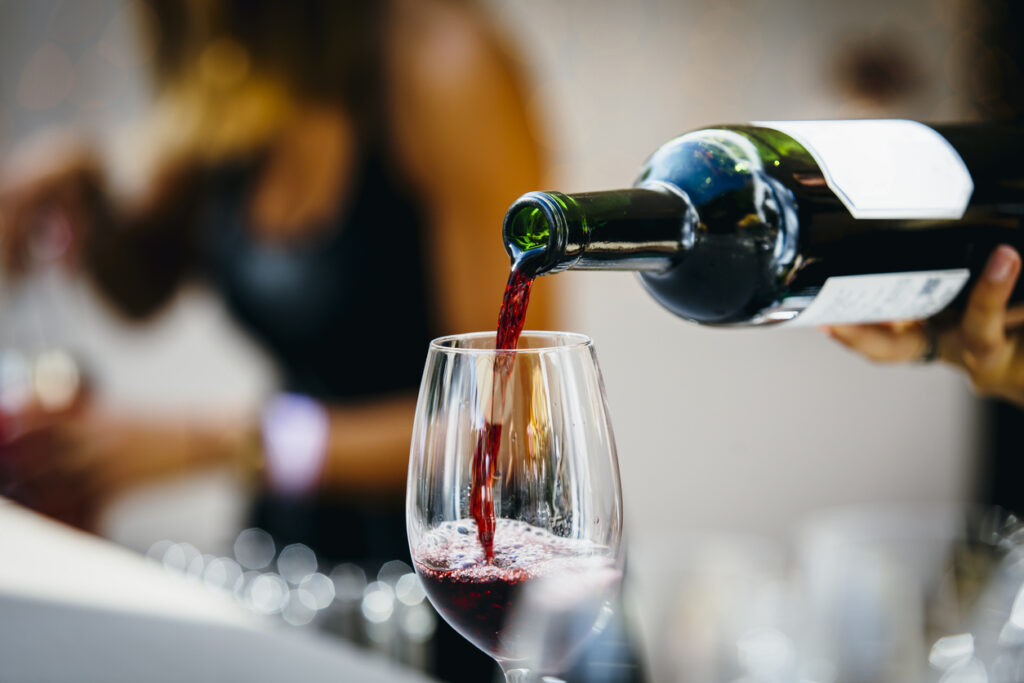
There are several factors that contribute to a wine’s body. These include alcohol content, tannins and residual sugar levels. Wines with higher alcohol content tend to feel fuller in the mouth while those with lower levels can feel lighter and more delicate. Similarly, wines with higher tannin levels (found predominantly in red wines) can add astringency and structure which contribute to their body.
Ultimately, understanding what body means when it comes to wine tasting is essential for developing your palate and being able to choose wines that suit your taste preferences.
Geographic origin bias
Wine Geographic Origin Bias: Debunking the Myth
When it comes to wine, the geographic origin of a particular bottle can play a significant role in how it is perceived. There’s no denying that certain regions, such as Napa Valley or Bordeaux, have earned reputations for producing exceptional wines. However, this geographic bias can often lead to overlooking equally delicious bottles from lesser-known regions.
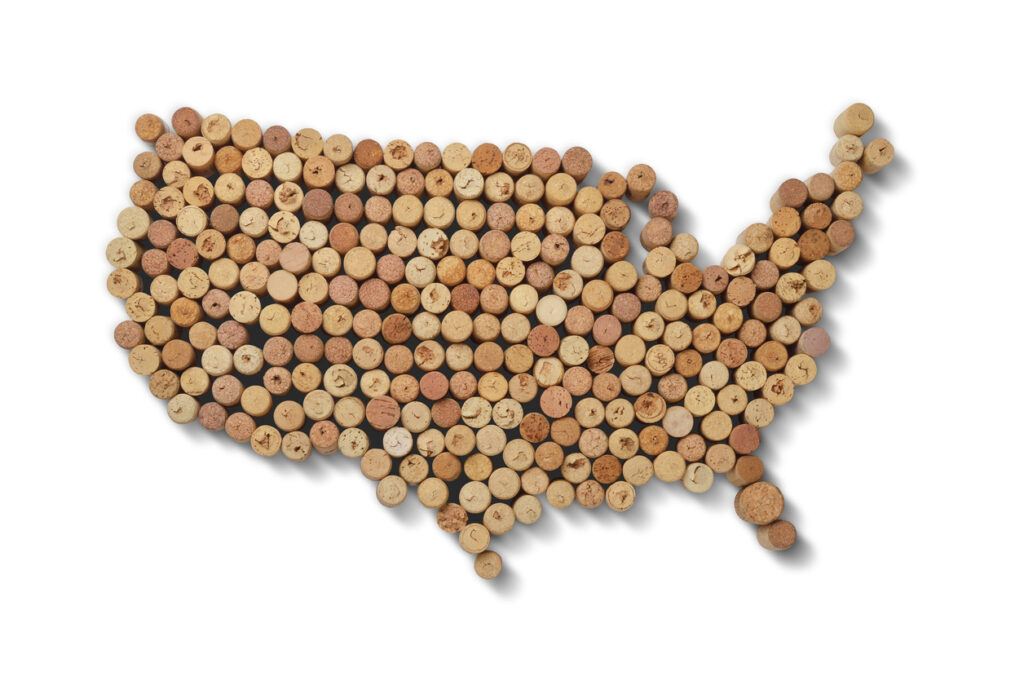
While there may be some truth to the idea that certain areas are better suited for growing specific grape varieties, there are countless exceptional winemakers all over the world who are crafting incredible bottles outside of those well-known regions. In fact, many smaller producers who lack name recognition can offer excellent value and unique flavors that set them apart from their more famous counterparts.
It’s crucial to remember that just because a wine doesn’t come from a renowned region doesn’t mean it isn’t worth trying.
Color bias
Wine Color Bias: Breaking the Stereotype
For years, wine lovers have been told that certain colors are associated with specific flavors and aromas. Red wine is often believed to be bold and full-bodied, while whites are thought to be light and refreshing. However, this stereotype overlooks the diverse range of flavors and aromas present in both red and white wines.
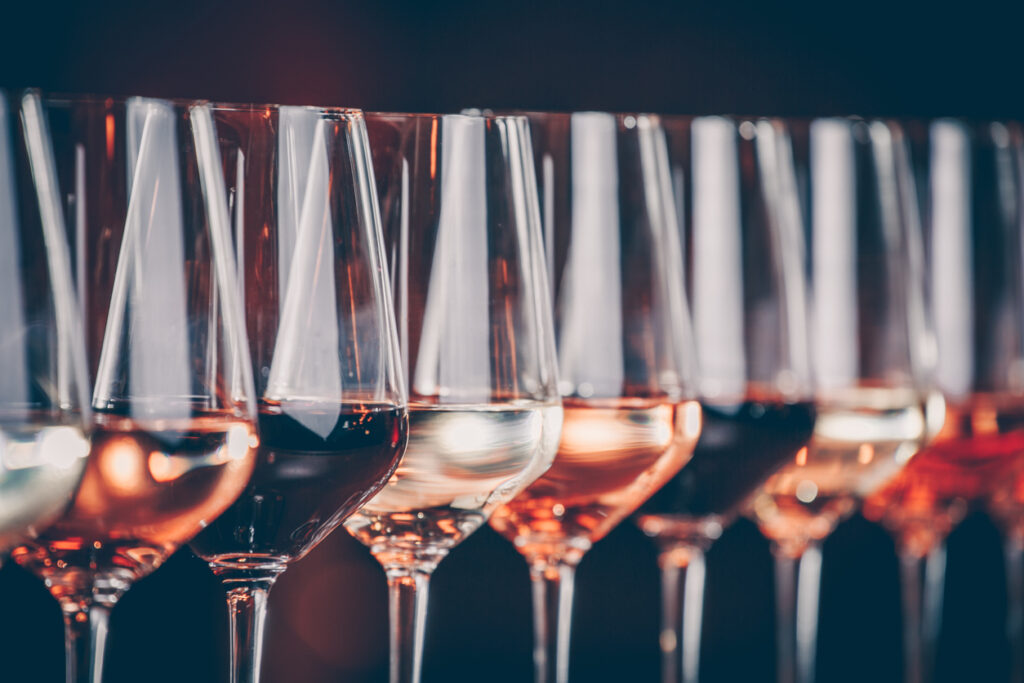
One of the biggest factors contributing to this bias is our perception of color. Studies have shown that people tend to associate darker colors with more intense or powerful experiences, such as strong flavors or emotions. This means that many people automatically assume that a dark red wine will be bolder than a lighter-colored white wine – even if the two wines have similar taste profiles.
However, it’s important to remember that color alone does not dictate flavor or aroma in wine.
Wine tasting
Wine tasting is a fun and interesting activity that allows you to explore different types of wine and discover new flavors. Whether you are a seasoned wine enthusiast or just starting to learn about wine, there are many ways to enjoy the experience. One popular method of tasting is using black wine glasses. These unique glasses hide the color of the wine, allowing you to focus solely on its aroma and taste.

Another exciting way to approach wine tasting is through blind tastings. Blind tastings involve sampling wines without knowing their names or origins, giving tasters an unbiased perspective on each wine’s quality. This approach encourages tasters to rely solely on their senses, making for a more objective assessment. Additionally, blind tastings can be used as a learning tool by comparing different wines’ characteristics and drawing comparisons between them.
Horizontal wine tastings
If you’re looking to expand your wine knowledge, then a “horizontal” tasting is an excellent way to deepen your understanding of different wines. A horizontal tasting involves sampling the same vintage from various wineries side-by-side. This method allows for a more in-depth comparison between each winery’s approach and style.
During a horizontal wine tasting, you can focus on the subtleties of each vintage and compare how different vineyards handle their grapes. You will taste the nuances that come from climate conditions, soil types, and grape varieties unique to each vineyard. This kind of tasting experience gives you the opportunity to develop your palate while also learning about different wineries and their respective approaches.

One of the highlights of a horizontal wine tasting is discovering new flavors that may not have been obvious before when tasted alone or with other vintages from the same producer.
Vertical wine tastings
Vertical wine tasting is a unique way to explore the nuances and complexities of different vintages of the same wine. This type of tasting involves sampling wines from different years that were produced by the same winery, using grapes grown in the same location. The main goal is to compare and contrast how each vintage has evolved over time, highlighting differences in flavor, aroma, color, and texture.
One of the main advantages of vertical wine tasting is that it allows you to appreciate how a particular vineyard has changed over time. You can see how various environmental factors like weather patterns and soil composition influence the final product. Additionally, vertical tastings enable you to get a better understanding of what makes a great vintage – which could be invaluable if you ever decide to invest in fine wines.

How to detect cheap and expensive wine
Wine is a popular and classic alcoholic beverage that is enjoyed by many. However, not all wines taste the same. There are cheap wines that may lack the flavor and quality of expensive ones. On the other hand, expensive wines can provide an exquisite taste and aroma that leave you wanting more.
One way to detect cheap wine is by its taste. Cheap wine often tastes flat or sour, lacking any depth or complexity in flavors. Expensive wines, on the other hand, can offer a wide range of complex and layered flavors with a long-lasting finish. These flavors may include fruity notes, oakiness from barrel aging, earthy undertones or floral aromas.
Wine defects
In the world of wine, detecting wine defects is crucial. Wine defects are flaws that can occur during the winemaking process, leading to an unpleasant taste or aroma. These defects can arise from a variety of sources such as problems with the grapes or fermentation issues. As a result, it’s essential for wine enthusiasts and professionals alike to be able to identify these defects in order to make informed decisions about their selection.
One common wine defect is spoilage yeast, which can produce a range of off-flavors and aromas in wines. This type of yeast is often found in vineyards and wineries and can cause problems during the fermentation process. Some signs that your wine may have been spoiled by this type of yeast include musty or moldy smells and flavors, as well as vinegar-like notes.

Wine tasting classes
Tasting Classes: The Perfect Way to Explore the World of Wine
If you’re interested in wine, there’s no better way to explore it than through wine classes. These classes give you a chance to sample different types of wines and learn about their unique characteristics. You can attend a beginner class if you’re just starting out, or take a master class if you’d like to learn from the best. One of the most renowned experts in this field is James Suckling, who is offering wine tasting classes “Master Classes” for those who want to take their knowledge of wine to the next level.
If you’re new to wine tasting events, attending a beginner’s class is an excellent place to start. In these classes, you’ll learn how to properly taste wine and identify its key components.

